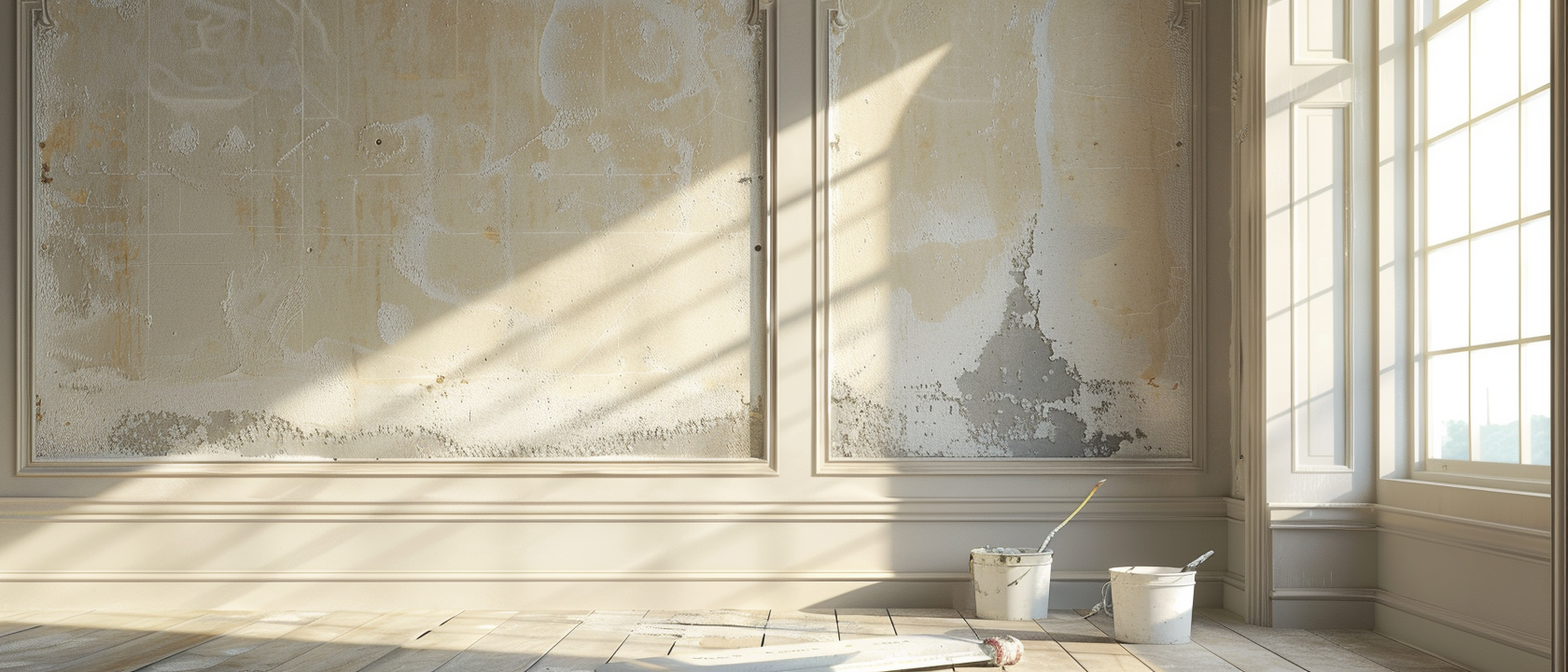STEP-BY-STEP GUIDE TO ACHIEVING A PROFESSIONAL FINISH ON YOUR INTERIOR WALLS
Step-by-Step Guide to Achieving a Professional Finish on Your Interior Walls
Achieving a flawless, professional-grade finish on interior walls can seem daunting, but with the right guidance on preparation, products, and application techniques, DIY enthusiasts can attain salon-quality results.
This comprehensive guide breaks down the key considerations around paint finishes, surface prep, application methods, and upkeep to help you tackle painting projects with confidence. Follow these pro tips and transform lacklustre walls into an elegant showpiece that enhances your home's aesthetic appeal.
Understanding Paint Finishes
Before deciding on a colour, first consider the functional purpose you want your interior paint to serve. Paint comes in various finishes that produce different surface sheens, each suited for specific applications. Let's examine the most common options:
Flat (matt)
Flat or matt finishes have no shine and a velvety smooth texture. They excel at hiding surface imperfections by diffusing light reflection. Best suited for low traffic areas like master bedrooms and formal dining rooms. While inexpensive and easy to touch up, flat paints are harder to clean and prone to scuff marks.
Eggshell
Slightly more lustrous than flat finishes, eggshell paints have a delicate sheen reminiscent of an eggshell. The subtle gloss makes them easier to clean and provides good durability for a matte-type finish. Ideal for moderate traffic living spaces like bedrooms, office areas, and rec rooms. Still vulnerable to marking but provides a classic, soft elegance.
Satin
The delicate pearl-like glow of satin finishes bridges matte and traditional gloss paints. More scrubbable than flat or eggshell, satin stands up well to moderate traffic while retaining its attractive lustre. Works excellently in kitchens, hallways, kids' rooms, and other high-use areas prone to grease and dirt exposure. Resists moisture better than lower sheens.
Semi-Gloss
The radiant look of semi-gloss gives a sleek, polished effect. It's easy cleanability makes it ideal for rooms exposed to grease, condensation, and frequent handling like corridors, bathrooms, kitchens, and laundry areas. Often used for doors, trims, and cabinetry. While durable and stain-resistant, imperfections easily show through semi-gloss’s reflective surface.
High Gloss
Boasting a striking mirror-like shine, high gloss finishes provide ultimate durability and water resistance. As the most light-reflective option, high gloss amplifies flaws and requires meticulous surface prep for a flawless look.
Use to accent focal walls or protect surfaces in heavy use wet areas like laundries and bathrooms. Also an excellent pick for trims, doors, and kitchen cabinetry in contemporary colour palettes. Easy to clean but also shows fingerprints and requires frequent polishing.
Choosing the Right Finish for Your Walls
Now that you understand the unique perks of each paint finish, use these key considerations around room function and traffic flow to narrow your selection:
Low Traffic Areas
For infrequently used rooms like master suites, studies, formal dining spaces, and guest bedrooms, flat or eggshell finishes work beautifully. These subtle sheens downplay wall imperfections while keeping cleaning hassles minimal. Stick with durable scrubbable eggshell for children’s bedroom walls that may experience occasional markings.
Moderate Traffic Areas
In multi-use living spaces like lounge rooms, home offices, and recreational areas exposed to regular foot traffic, consider durable satin or eggshell finishes. Eggshell retains a classic elegance while satin offers enhanced cleanability and resilience to occasional bumps and scrapes.
High Traffic Areas
For wall surfaces prone to heavy usage, moisture, staining, and potential damage in kitchens, bathrooms, play areas, and hallways/stairwells, semi-gloss or high gloss finishes provide the ultimate protection.
While semi-gloss provides polished sheen and resistance for affordable protection, high gloss ups the ante with mirror-like reflectivity and impervious moisture defence. Use high gloss selectively on accent walls or install semi-gloss throughout high-activity zones.
In wet zones like bathrooms and laundry rooms, moisture-resistant finishes prevent growth of mould, mildew, and bacteria. Satin resists humidity well for a softly glowing look, but for ultimate water defence on sinks, backsplashes, and tub/shower surrounds, upgrade to semi or high gloss finishes.
Kitchens also endure spills, splatters, and condensation around ranges, dishwashing, and refrigerator areas. Again, spec in satin, semi, or high gloss finishes around these moisture-prone spaces. Consider wipeable glass board paint on pantry or mudroom walls for erasable notes and reminders.

Step-by-Step Painting Process
With your preferred paint sheen and colours selected, now let’s examine the professional painting process for flawlessly executed results:
Preparation
Thorough prep work ensures paint adheres optimally for smooth, enduring finish. Fill cracks and holes with spackle, then sand bumps, drips, glossy, or damaged areas to create a uniform surface profile.
Clean walls using TSP cleaner then rinse thoroughly. For previously painted walls in sound condition, gently sand to degloss before wiping clean of dust. Allow surfaces to fully dry before priming or painting.
Priming
Quality primer helps paint bind tightly while blocking stains, tannins, and texture differences for evenly absorbed topcoats. Opt for tinted primers closest to your finish shade. Apply primer generously using overlapping strokes, allowing 2 hours minimum dry time before painting.
For drastic colour changes, dark hues may require an extra priming coat to prevent bleed-through.
Painting
Once primed surfaces are fully cured and dry, now the wall transformation magic happens! Follow these pro application tips:
Cutting In
Initially paint wall edges, corners, trims, and ceiling lines using angled trim brushes for precise control, followed by rolling larger expanses. This “cutting in” achieves sharp no-tape lines. Take care not to overload bristles–excess dripping slows drying. Maintain a wet edge for continuous looks.
Rolling Paint
Pour paint into roller trays for easy loading onto applicator covers. Use quality mini rollers sized right for your surfaces; typical wall rollers span 9 inches while trim/cut-in rollers run 4 inches. Load roller evenly without oversaturation, then roll off excess paint before applying finish coats. Use modest pressure in overlapping “W” and “V” motions, blending sections seamlessly while maintaining a wet look. For textured surfaces, adjust angles to coat contours completely.
Applying Multiple Coats
Plan on applying multiple thin coats for best results, allowing proper drying between layers as specified by the manufacturer. Thick single coats risk unsightly drips while inadequate coverage leaves uneven sheen or hints of underlying colours peering through. Patient, repetitive thin coats deliver superior, enduring results. For darker dramatic hues, extra coats prevent show-through of prior lighter wall colours.
Finishing Touches
Once painting completes, now finalise your makeover results: carefully pry off masking tapes within 24 hours before adhesion builds. Inspect for any missed spots or patchy areas, smooth with trim brushes. Confirm thorough coverage, allowing sheen to fully develop over 7+ days’ cure time. Clean rollers and brushes thoroughly after use. Finally, vacuum/sweep errant drips, safely dispose of paint cans/trays, and meticulously clean the workspace.
Additional Tips for a Professional Finish
Beyond fundamental painting procedures, deploy these advanced professional painter techniques:
Lighting: Illumination impacts perceived colour intensity and sheen visibility. Assess your finish options under your room’s actual lighting conditions.
Contrast: Pair glossy trims with flat or eggshell wall colours for striking definition. Define architectural details through strategic sheen variations.
Dark Colours: Deep dramatic hues like navy and charcoal show more surface defects. Stick with medium value neutral tones or upgrade to higher sheens to minimise noticeable flaws behind richer colours.
Application Tools: Invest in quality brushes, mini rollers, trays, and painter’s tape for easier, faster, and cleaner painting experiences. Maintain tools per manufacturers’ directions.
Maintenance Tips
Preserve your elegant painted finishes by:
- Gently dusting with microfiber cloths to avoid scuff marks
- Spot cleaning with manufacturer-approved cleaners compatible with your paint’s sheen
- Avoiding abrasive scrub pads/brushes and harsh chemicals
- Touching up occasional light scuffs with original paint to protect underlying layers
When paint loses lustre despite gentle handling, apply fresh coats as needed to revive to a salon-quality appearance.
Why Hire Professional Painters and Decorators?
While avid DIY-ers can certainly produce lovely painted finishes independently, for extensive whole home painting or tricky specialty techniques, consider hiring professional painters and decorators for outstanding results. Their mastery of materials, methods, tools combined with years of hands-on experience guarantees a magazine-shoot flawless finish with incredible durability. Reap benefits of:
- Total project management from concept to completion
- Meticulous surface prep and treatment of problem substrates
- Efficient application for faster turnaround times
- Access to commercial-grade paints and specialty finishing products unavailable to consumers
- Custom faux treatments like venetian plaster, marbling, graining and glazing
- Superior warranty protections backed by years in business
- Hassle-free cleanup and disposal
Though seemingly basic, intricate professional skills go into painting to create museum-quality finishes that enhance home beauty and value.
Conclusion
Achieving high-calibre painted finishes involves careful consideration around paint sheens, surface preparation, application techniques, and upkeep. Evaluate room functions, traffic patterns and desired aesthetics to select optimal finishes. Eggshell, Satin, and Semi-Gloss offer excellent durability and style for most interior walls and trimworks.
Follow proven methods for cleaning, priming, cutting-in, rolling, and applying multiple thin finish coats. Maintain painted results through gentle cleaning and timely touch ups.
While DIY novices can produce lovely looks, for expansive whole-home transformations or ornate specialty treatments, hire professional painters and decorators for outstanding enduring outcomes. With this guidance, now transform lacklustre walls into glamorous showpieces that wow.
About Borthwick Decorators Ltd
At Borthwick Decorators Ltd you have found one of Scotland’s leading hand painted and spray painted kitchen companies, where quality, reliability and professionalism come as standard. We are based in Edinburgh, with affiliated branches in Glasgow, Perth, Stirling and Crieff which allows us to cover the whole of Central and South Scotland.
We are a Painting and Decorating Association and Scottish Decorators Federation accredited business that offers all aspects of interior and exterior painting and decorating. All of our tradespeople are fully qualified painters and decorators. We also offer plastering, joinery and multi-trade services in conjunction with our painting and decorating jobs. Residential painters and decorators since 1959.
If you have any questions regarding the painting and decorating services we offer or you would like to book a free no obligation quotation, please don't hesitate to get in touch with us via our online appointment form or alternatively by sending us an email or by telephoning 0131 235 2733 or 0800 772 3973 .












